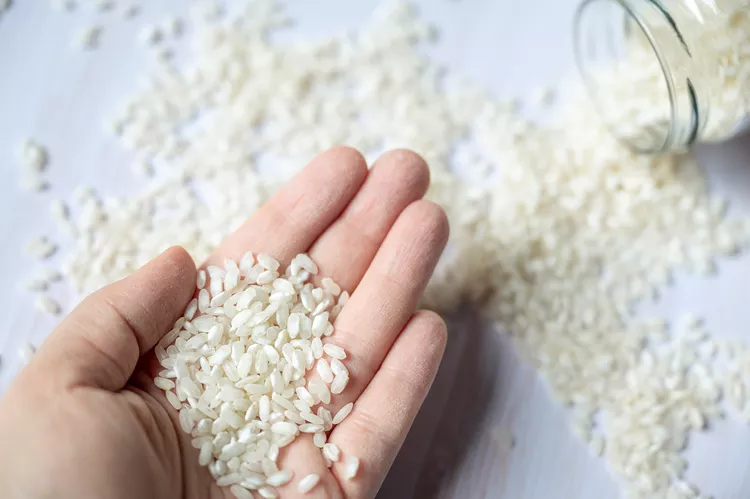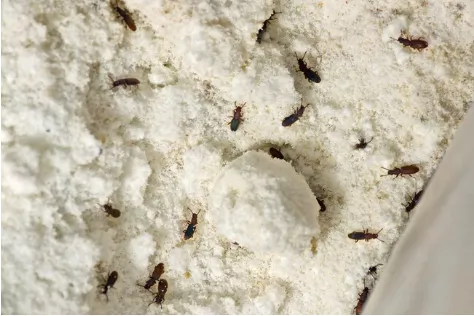Weavil Control (Weavils)
Get Free Quote
What are Weavils?
Weevils have a life cycle that includes four stages: egg, larva, pupa, and adult. Female weevils lay their eggs inside plant material, such as grains, seeds, nuts, or wood, depending on the species. The larvae, which hatch from the eggs, feed on the plant material and are often responsible for significant damage to crops and stored food products. The larval stage is usually the most destructive phase of their life cycle. After completing their development, the larvae pupate and transform into adult weevils. Adults may also feed on plants, but their primary role is to reproduce and lay eggs to continue the cycle.
Weevils are often considered pests due to their ability to infest and damage crops, stored food products, and other plant materials. They can cause significant economic losses in agriculture and food storage. Some common examples of weevil species include the grain weevil, which infests stored grains, and the boll weevil, which targets cotton crops. Despite their reputation as pests, weevils play an essential role in the ecosystem by helping decompose plant material and serving as a food source for other animals. Understanding the biology and behavior of weevils is crucial for managing their impact on agriculture and food storage.
Why Are Weavils at My Property?
Weevils may be at your property for several reasons, primarily related to their search for food and suitable environments for laying eggs. Here are three detailed paragraphs explaining why weevils might be present at your property:
Search for Food Sources
Weevils are attracted to properties where they can find an ample supply of food. They primarily feed on grains, seeds, nuts, and other plant materials. If you have stored grains, cereals, flour, pasta, or other dry goods in your pantry or storage areas, these could be attracting weevils. The presence of birdseed, pet food, or improperly stored food products can also provide a food source for these pests. Outdoor areas with gardens or compost heaps that contain plant debris may further attract weevils seeking food.
Suitable Breeding Environments
Weevils look for environments where they can lay their eggs and ensure the survival of their offspring. They often lay eggs inside grains, seeds, or other plant materials, where the larvae can feed as they develop. If your property provides such environments, it can become a breeding ground for weevils. This includes not only stored food items but also natural areas like gardens, where certain plant species can attract specific types of weevils. Warm, humid conditions typical in some parts of the year can also create an ideal environment for weevil reproduction.
Entry Points and Shelter
Weevils can enter homes and properties through various entry points, such as cracks and crevices around windows and doors, gaps in the foundation, or vents. They are often small enough to go unnoticed until an infestation becomes apparent. Once inside, they seek out shelter and food sources. Weevils are also known to hitchhike on food products or plants brought into the home. For instance, purchasing infested grains or seeds from a store and bringing them into your property can introduce weevils to your home. Additionally, natural habitats like woodpiles, leaf litter, and mulch around the property can provide shelter for weevils, allowing them to thrive close to your home.

Risks Associated with Weavils
Weevils pose several risks, particularly in homes and food-related businesses, primarily due to their penchant for infesting stored food products. When weevils invade, they can contaminate large quantities of food, leading to significant wastage. Infested products often become unfit for consumption as weevils and their larvae can cause damage and leave behind debris, including fecal matter and dead insects. This contamination not only results in financial losses due to the need to discard and replace affected goods, but it also raises health concerns. Consuming contaminated food can cause digestive discomfort or allergic reactions in sensitive individuals.
In addition to the direct contamination of food, the presence of weevils can harm a business’s reputation, especially in the food industry. Customers expect high standards of cleanliness and safety from food producers and retailers. Discovering weevils in products can lead to a loss of trust and a decline in business. Furthermore, weevils can impact the structural integrity of packaging, making it easier for other pests to enter and cause further damage. For homeowners, the inconvenience and distress caused by a weevil infestation can also not be overlooked, as it often requires thorough cleaning and preventive measures to ensure the problem does not recur.
Request A Free Quote
What are the steps to Weavil Control

Identify Infested Areas: Begin by thoroughly inspecting your home to locate areas where weevils are present. Check pantry shelves, cabinets, and storage areas where dry food products are kept. Look for signs of infestation such as small holes in packaging or grains, and live or dead weevils.
Remove and Dispose of Infested Items: Carefully remove all infested food products and dispose of them in sealed plastic bags to prevent the spread of weevils. This includes grains, cereals, flour, pasta, and other dry goods that show any signs of infestation.
Clean and Vacuum: Clean the affected areas thoroughly by vacuuming shelves, cracks, and crevices to remove any weevils, larvae, and eggs. After vacuuming, wipe down the surfaces with a solution of warm soapy water or a mild disinfectant. Ensure all corners and hard-to-reach areas are cleaned.
Store Food Properly: Transfer remaining uninfested food items into airtight containers made of glass, metal, or heavy plastic. This prevents weevils from accessing the food and laying eggs. Label the containers with the date of storage to help with inventory management.
Use Natural Deterrents: Place natural deterrents such as bay leaves, cloves, or neem leaves inside pantry shelves and containers. These can help repel weevils without the use of chemicals.
Monitor Regularly: Conduct regular inspections of your pantry and storage areas to detect any signs of new infestations early. Check the condition of food containers and maintain cleanliness to prevent re-infestation.
Steps to Weevil Control for Food Factories
Inspection and Identification: Conduct a thorough inspection of the entire facility, including storage areas, production lines, and packaging areas. Identify any signs of weevil presence, such as damaged packaging or sightings of weevils. Use traps and monitoring devices to gauge the level of infestation.
Quarantine and Dispose of Infested Products: Immediately quarantine any infested products to prevent the spread of weevils. Dispose of these products according to proper waste management protocols, ensuring they are sealed and removed from the facility promptly.
Sanitation and Cleaning: Implement a deep cleaning protocol for the entire facility. This includes vacuuming and washing all surfaces, machinery, and storage areas. Pay special attention to cracks, crevices, and other hard-to-reach areas where weevils and their eggs might be hiding.
Pest-Proof Storage: Store raw materials and finished products in weevil-proof containers. Use bins with tight-fitting lids and ensure all packaging materials are resistant to pest entry. Regularly inspect and maintain these storage solutions to ensure their effectiveness.
Implement Integrated Pest Management (IPM): Develop an IPM plan that includes routine inspections, monitoring, and the use of non-chemical and chemical control methods as necessary. This might involve using pheromone traps, natural predators, or approved insecticides in extreme cases.
Employee Training and Protocols: Train all employees on the importance of pest control, proper storage practices, and cleanliness. Establish protocols for regular inspections, reporting infestations, and immediate response actions to contain and eliminate weevils.
Regular Audits and Monitoring: Conduct regular audits of pest control measures and monitor the facility for signs of weevil activity. Use data from traps and inspections to identify trends and areas that may need additional focus. Adjust pest control strategies based on findings to ensure continuous protection.
Accend Solutions is Available 24/7 for Emergency Pest Control including Mice Control in Gauteng and North-West Provinces in South Africa.
email: info@accend.co.za
call: 068 474 7303
FAQs on Weavil Control
We know you may have questions about Weavils in general and how Pest Control for Weavils work. We have compiled a few FAQs on Weavils that might clear the confusion.
CLICK HERE FOR FAQs ON WEAVILS/ WEAVIL CONTROL
1. What are weevils and where do they come from?
Weevils are small beetles known for infesting stored food products like grains, cereals, flour, and rice. They can enter homes and food storage facilities through infested food items purchased from stores or markets.
2. How do I know if I have a weevil infestation?
Signs of a weevil infestation include finding small holes in food packaging, presence of tiny beetles or larvae in food products, and a floury or musty odor coming from infested items. Weevils are often spotted in pantry shelves or near food storage areas.
3. Are weevils harmful to health?
While weevils themselves are not harmful if ingested, consuming infested food can cause digestive discomfort or allergic reactions in some individuals. They can contaminate food with their feces, cast skins, and dead bodies, making it unsuitable for consumption.
4. How can professional pest control services help with weevil infestations?
Professional pest control services use effective methods to eliminate weevils from homes and food facilities. They conduct thorough inspections to locate infested areas, implement targeted treatments using safe and approved insecticides, and provide recommendations for preventing future infestations.
5. What steps are involved in professional weevil control? Professional weevil control includes:
- Inspection: Identifying areas of infestation and assessing the extent of the problem.
- Treatment: Applying insecticides to targeted areas where weevils are present.
- Monitoring: Regular follow-ups to ensure the effectiveness of treatments and prevent re-infestation.
- Prevention: Advising on proper food storage practices and sealing potential entry points to deter weevils.
6. Is professional weevil control safe for homes and food facilities?
Yes, professional pest control services prioritize the safety of residents and food safety standards. They use products and techniques that are approved for use in homes and food handling areas, ensuring minimal risk to people, pets, and the environment.
7. How long does it take to get rid of weevils with professional pest control?
The time frame for eliminating weevils depends on the severity of the infestation and the effectiveness of treatments. In most cases, multiple treatments and ongoing monitoring are needed to ensure complete eradication and prevent re-infestation.
8. Can I prevent weevils on my own without professional help?
While basic prevention measures like proper food storage and regular cleaning can help reduce the risk of weevil infestations, professional pest control services offer specialized knowledge and treatments that effectively address infestations and provide long-term prevention strategies.
9. What should I do if I suspect a weevil infestation?
Contact a professional pest control company immediately for a thorough inspection and appropriate treatment. Avoid discarding infested food items until they have been properly assessed by a pest control expert.
10. How much does professional weevil control cost? The cost of professional weevil control services varies depending on factors such as the size of the infested area, severity of the infestation, and the treatment methods used. It is advisable to request a quote from a reputable pest control provider to understand the specific costs involved.
